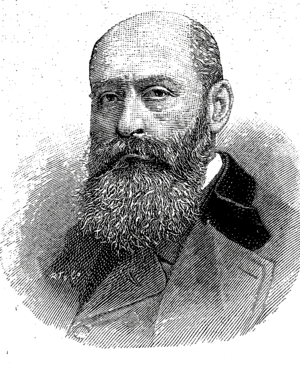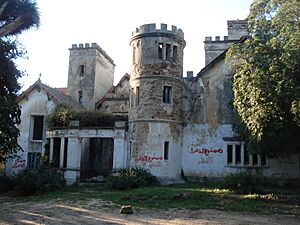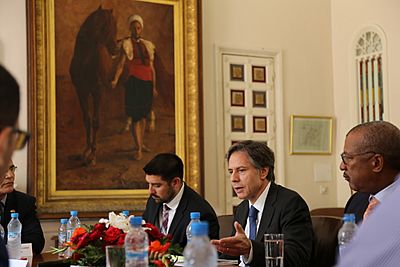Ion Hanford Perdicaris facts for kids
Quick facts for kids
Ion Hanford Perdicaris
|
|
|---|---|

Portrait of Ion
|
|
| Born | April 1, 1840 Athens, Greece
|
| Died | May 31, 1925 (aged 85) London, England
|
| Resting place | Saint Nicholas Church Yard Chislehurst |
| Nationality | American |
| Alma mater | Harvard University (dropped out) |
| Known for | Portriat of Ellen Varley |
|
Notable work
|
Resurgamus |
| Movement | American Art |
| Spouse(s) | Ellen Varley nee Rous |
| Personal details | |
| Profession | Writer, Painter, Diplomat and Activist |
| Known for | International Diplomacy, Moroccan Studies |
Ion Hanford Perdicaris (born April 1, 1840 – died May 31, 1925) was a very interesting person. He was a writer, professor, lawyer, painter, and even a playwright! He cared deeply about people and fought for human rights.
Ion worked to help Moors, Arabs, and enslaved people. He was active in the movement against slavery in the United States and in Morocco. He also tried to change an unfair system in Morocco called the Protégé system. Ion became famous around the world because of an event known as the Perdicaris Incident.
He was born in Athens, Greece, but grew up in Trenton, USA. He went to Harvard University for a short time. Then he traveled to Europe for more schooling. He left the United States during the American Civil War. This was because his mother's family was from South Carolina and supported the South. Ion even gave up his American citizenship. He tried to become a Greek citizen. This was to stop his family's gas company from being taken away.
Ion often traveled between London and the United States. He wrote articles for The Galaxy magazine. He lived a fancy life and went to special gatherings called seances. In 1872, he married Ellen, who was the wife of C. F. Varley. By the 1880s, Ion and his parents moved to Morocco. They built a large house there called the Place of Nightingales. In Morocco, Ion became very involved in helping the local Moorish people. He wrote many essays and a book to support their rights.
In May 1904, Ion was kidnapped by Mulai Ahmed er Raisuni. Raisuni's group raided Ion's house. They took him and his stepson, Cromwell Varley, up into the mountains. Theodore Roosevelt, who was the U.S. President, reacted strongly to this event. It became known as the Perdicaris affair and got a lot of attention. Ion later returned to the United States for a short time. He then lived the rest of his life in a large house in Chislehurst, England. Ion and Ellen Varley were buried at Saint Nicholas Church Yard in Chislehurst.
Contents
Ion's Early Life
Ion Hanford Perdicaris was born in Athens, Greece. His father, Gregory Anthony Perdicaris, was the United States Consul in Greece. This meant his father was a diplomat, representing the U.S. in Greece. Ion's father had moved to the United States from Greece in the late 1820s. Ion’s mother was from a wealthy family in South Carolina. Her grandfather was a hero of the American Revolutionary War.
Ion’s family moved back to the United States in 1845. They lived in a large, fancy house called the Perdicaris Ashley Cottage. It was in Trenton, New Jersey. Ion grew up in Trenton and went to the Trenton Academy. His father was on the school's board. The school was for children from important and wealthy families. By age ten, Ion was involved in his family's business. But he preferred painting instead. His paintings decorated their mansion. His father, Gregory, became very rich.
During the American Civil War
Perdicaris finished school at Trenton Academy in 1855. He wrote an essay called Unity of Beauty. The next year, he started at Harvard University. He also showed his painting Cattle at an art exhibition. By 1858, Ion was no longer at Harvard. He went to England to study painting.
Some of Ion's family supported the Confederate States of America during the American Civil War. They wanted him to help their side. His father, a former diplomat, knew many people in Europe. This included the King and Queen of Greece. This information was shared with the McIver family, who were Ion's cousins and strong supporters of the Confederacy.
The McIver family took over the Perdicaris family's property in South Carolina. They called them "alien enemies." This happened soon after the Civil War began. Later, the Confederacy took 1,351 shares of the Charleston Gas Light Company. These shares belonged to Gregory and were worth a lot of money.
Ion's parents told him to get Greek citizenship. They hoped this would stop their property from being taken. But at that time, it was not easy to change citizenship. Ion sent his paperwork to become Greek before the shares were taken. But by law, he was still an American citizen.
Life in London
Ion grew up in a family that knew a lot about diplomacy. His father was the first American Consul to Greece. By the 1860s, Ion was a lawyer living in London. He traveled the world. He started spending time with people in the diplomatic community.
From a young age, Ion loved to write. He published several articles in The Galaxy, a magazine from New York City. His first article was about painting. He wrote more articles about art and exhibitions.
Perdicaris lived at two different addresses in London. He was also interested in spiritualism and séances. A famous engineer named Cromwell Fleetwood Varley and his wife, Ellen Varley, were also interested in these topics. They attended seances with Ion and other wealthy people. In 1872, Ion married Ellen Varley.
Back in Trenton, New Jersey
Ion returned to the United States in late 1874 with his new wife, Ellen Varley. She was 37 years old and had four children from a previous marriage. Her children were Ada, Cromwell Oliver, Hebe, and Fleetwood E. Varley.
Ion showed his painting called Moorish Interior at a big exhibition in 1876. Soon after, Ion, Ellen, and the children traveled to Morocco. The next year, newspapers in Trenton reported that Ion helped free an enslaved person in Morocco. The United States government helped him.
While living in London, Ion had been looking for a place to build a summer home by the Mediterranean Sea. He chose Morocco after talking to a French naval officer. Ion built two houses in Morocco.
They started building a famous mansion called the Place of the Nightingales, also known as Idonia or Aidonia, in Morocco in the 1870s. Their second home in Morocco was a city house called El Minzah. Ion and his family returned to the U.S. so his stepdaughter, Ada Varley, could perform in a play on Broadway. Ada and her husband became well-known stage actors.
Ion produced two plays in New York City in 1879. One play, called The Picture, featured a huge painting by Ion. It was called Resurgamus (Combat of Life, Terror of Death and Triumph of Immortality) and was very large.
Life in Morocco
Both of Perdicaris's parents moved from Trenton to join their son in Morocco. His father passed away in Morocco in 1883, and his mother died two years later. Ion hosted many fancy parties at his large estate. He was very involved in diplomatic matters in the area. His stepdaughter, Hebe Varley, married a diplomat from the Italian embassy in Morocco.
Ion convinced the Sultan to create the Tangier Hygienic Commission. Around this time, it was common to arrest people who couldn't pay their debts in Morocco. Perdicaris spoke up for the poor Moors and Arabs who were unfairly imprisoned for debts. Rich lenders used the protégé system to control and mistreat the local people. Ion wrote essays and a book about the Treaty of Madrid. He also wrote a pamphlet called American Claims in Morocco and a novel called The Case of Mohammed Benani. He was interviewed by a reporter in 1887. The interview was called The European Vampire in Morocco and talked about the harsh treatment of the Moors and the protégé system.
In 1886, Ion was briefly arrested. This happened because he started an investigation against a public official. After a year, Ion helped get that official replaced. In 1887, a celebration was held at Ion's estate when the new official arrived. The local people thanked Ion for helping them get out of prison. This event was also reported in American newspapers.
Ion's wife, Ellen, was the president of a charity group in Tangier. Ion was the vice-president of the Tangier Hygienic Commission. In 1887, Ion suggested that Tangier should be a special neutral port. This would be controlled by the world's major powers. In 1893, the Commission's job grew to include public roads.
Both Ellen and Ion cared about the poor. Ellen ran a soup kitchen. Every Wednesday, Ion and his wife hosted fancy dinners and parties for the local important people. Ion continued writing towards the end of the century. He finished two essays: Currency and The Condition of Morocco.
By the late 1890s, a wealthy friend from Trenton, Samuel R. Gummeré, visited Ion in Morocco. Gummeré later became the U.S. Consul to Morocco.
The Perdicaris Affair
Ion's mansion, the Place of the Nightingale, was attacked by 90 to 200 bandits on May 18, 1904. Ion and his stepson, Cromwell Varley, were kidnapped by Mulai Ahmed er Raisuni. They were taken to the mountains. Ion broke his leg during this event. The U.S. Consul, Samuel R. Gummere, told the U.S. Government about the kidnapping. Ion was in the mountains for several weeks. Ion and his kidnapper became quite friendly. This event is sometimes seen as an example of Stockholm syndrome. Because of Ion's background and wealth, the United States sent its navy to Morocco by May 30.
The incident became very big in the news. This was partly because Theodore Roosevelt, the U.S. President, needed good publicity for his re-election campaign. The famous saying "Perdicaris Alive or Raisuli Dead" became well known. Ion returned to the United States as an international celebrity around June 24, 1904.
This was not the first time Ion involved the U.S. government. He had helped free an enslaved person in Morocco with U.S. help. He also indirectly caused two U.S. Consuls to be replaced because of his issues with the Protégé system. The kidnapping was the biggest event. His close friend, U.S. Consul Samuel Gummere, even had the U.S. Navy surround Morocco.
Back in the United States
Ion wrote articles about the Moors and the rich people who treated them badly. He was famous around the world when he returned to the United States. This attention gave him a chance to talk about Moroccan culture to people in the U.S. He wrote many articles about Morocco for American publications. He traveled across the country, giving talks about his kidnapping. The American media loved the story. Perdicaris even wrote a funny guide called How to Enjoy Captivity with Raisul by His Former Captive Mr. Ion Perdicaris.
In an article for National Geographic, Ion described the people of Morocco. He said there was no difference in color in the region. He also explained that the elite guards were from Sudan. He described a ruler named Ahmed bin Mūsa as one of Morocco's best leaders. Ion also gave lectures for the National Geographic Society.
Ion still had a lot of money from the coal and gas companies his father started. These companies were becoming electric companies. He also owned large areas of land in Trenton, New Jersey. The city of Trenton even considered buying one of his properties for a new city hall. Ion continued to give lectures and travel the world. He focused on international diplomacy and Moroccan history and culture. He moved back to England when he was seventy years old.
Later Life and Retirement in London
After 1910, Ion moved back to England. He bought a large house called The Manor House in Chislehurst, Kent. Even at seventy, he continued to host diplomatic parties at his big estate. His granddaughter married the Secretary of the Russian Embassy. Cromwell Varley, his stepson, continued to live with his mother and stepfather. Ellen Varley died in 1920. Ion lived another five years and died in 1925 at 85 years old. Both Ellen and Ion were buried at Saint Nicholas Church Yard in Chislehurst, London. He left a very large fortune.
Notable Homes
Ion grew up in a fancy mansion in Trenton called the Perdicaris Ashley Cottage. He later built two homes in Morocco. When he returned to the United States, he briefly stayed at the Ellarslie Mansion in Trenton. He sold the Perdicaris Ashley Cottage in 1895. He later moved to England and lived in a huge house in Chislehurst called The Manor House. By 1913, he sold one of his two homes in Morocco, El Minzah. He still owned The Place of the Nightingale, also known as Idonia or Aidonia.
In 1936, the Perdicaris Ashley Cottage was bought by a wealthy developer. His Moroccan mansion El Minzah was turned into a hotel. Around 2018, it was announced that the Place of Nightingales would be restored.
Artwork by Ion Perdicaris
- Composition (1855)
- Cattle (1856)
- Amalthea
- Moorish Interiors (1876)
- Resurgamus (Combat of Life, Terror of Death, and Triumph of Immortality) (1879)
- Portrait of Ellen Varley Perdicaris Room The American Legation Tangier, Morocco
- Man with Horse Perdicaris Room The American Legation Tangier, Morocco
Ion's Writings
Essays
- Unity of Beauty (Graduation Essay Trenton Academy 1855)
- English and French Painting (The Galaxy Volume 2 1866)
- Reminiscences of a Parisian Atélier (The Galaxy Volume 3 1867)
- The Exhibition of the Royal Academy (The Galaxy Volume 4 1867)
- Art and Modern Inventions (The Galaxy Volume 6 1868)
- American Claims and the Protection of Native Subjects in Morocco (Pamphlet 1886)
- Currency (The Free Review Volume 2 1894)
- The Condition of Morocco (The Asiatic Quarterly Review 1896)
- The Straits of Gibraltar and the Sultanate of Morocco (Pamphlet 1904)
- Morocco the Land of the Paradox (Asian Review 1904)
- The General Situation in Morocco (The North American 1905)
- The Spectator (The North American 1905)
- The Disintegration of Morocco its Immediate Causes and Probable Results (The International Quarterly 1905)
- Morocco the Land of the Extreme West and the Story of my Captivity (National Geographic Magazine 1906)
- Tangier in the Early 70s (Putnam's Monthly 1907)
- How to Enjoy Captivity with Raisul by His Former Captive Mr. Ion Perdicaris (The Sketch 1907)
Books
- The Case of Mohammed Benani (1887)
- Biography The Hand of Fate (1921)
Plays
- La Societaire (1879)
- The Picture (1879)
Estates
- Perdicaris Ashley Cottage (Trenton N.J.) (1845-1895)
- Place of the Nightingales (Tangier Morocco) (1877-1925)
- The Manor House, Chislehurst Kent (Kent England) (1910-1925)





